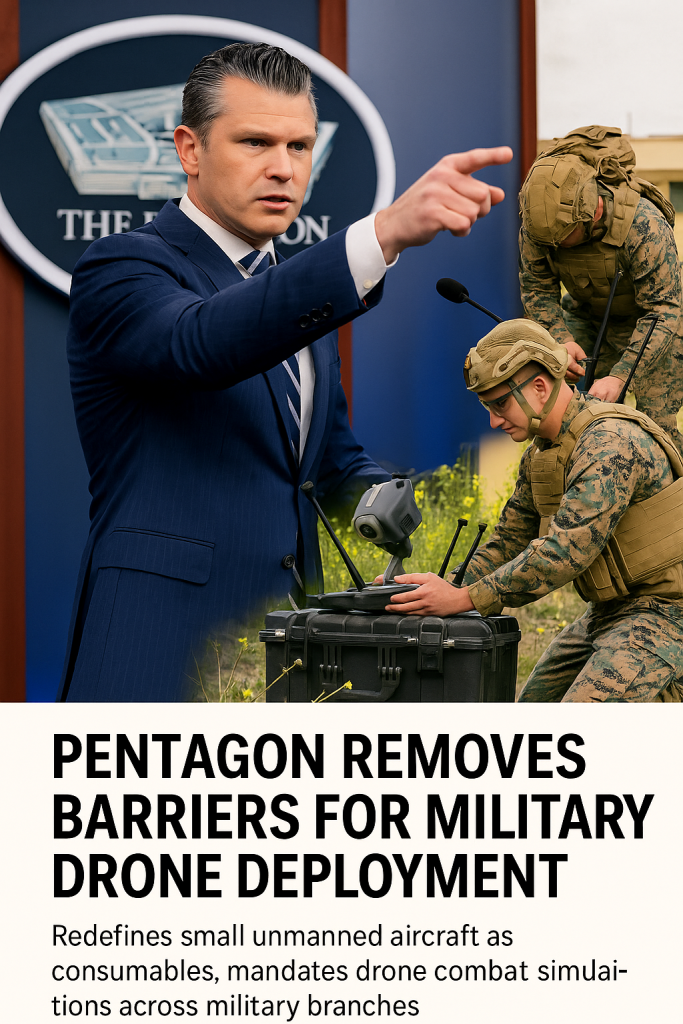The Pentagon has announced a sweeping update to its military drone policy, significantly accelerating the deployment of small unmanned aerial vehicles (UAVs) by officially redefining them as consumable assets. This strategic shift is paired with a mandate requiring rigorous drone combat simulations across all military branches, underscoring the growing importance of unmanned systems in modern warfare.
Until recently, small drones faced operational and logistical hurdles that restricted their rapid deployment. These ranged from concerns over cost-effectiveness and equipment reuse to bureaucratic red tape associated with military asset management. However, in 2024, the Department of Defense (DoD) has taken decisive steps to overcome these barriers by treating small UAVs the same way the military treats ammunition or expendable supplies — as items intended for single or limited-use engagement.
This fundamental reclassification is expected to radically alter how drones are acquired, deployed, and replaced on the battlefield. By accepting that small drones are consumables, commanders are empowered to utilize them aggressively, without the hesitation that might come from preserving equipment for reuse. The Pentagon sees this as a critical adaptation to the evolving combat environment, where rapid reconnaissance, swarm tactics, and high attrition rates are common.
At the heart of the new policy is a clear recognition that UAVs are not just technology assets but tactical tools that must be able to be used extensively and often without administrative delay. This consumption model unlocks faster procurement pipelines and streamlines regulations, facilitating a more responsive drone force perfectly tailored for today’s fast-paced conflicts.
Additionally, the DoD has mandated comprehensive drone combat simulations across all military branches — the Army, Navy, Air Force, Marine Corps, and Space Force. These simulations are designed to hone operational readiness, improve inter-service coordination, and prepare personnel to utilize small UAVs effectively in various combat scenarios. The simulations will incorporate swarm drone tactics, electronic warfare countermeasures, and rapid response coordination, reflecting evolving battlefield realities.
Military officials describe these simulations as a vital component of a “drone-centric” future of warfare. By training extensively before deployment, troops will gain better situational awareness and tactical flexibility. This, combined with the new consumable classification of drones, prepares the U.S. armed forces for scenarios where speed, scalability, and adaptability trump traditional conservation of equipment.
The move also aligns with broader defense modernization efforts aiming to integrate artificial intelligence, autonomy, and next-generation weapon systems. Small UAVs have become increasingly sophisticated, featuring advanced sensors, encrypted communications, and capabilities allowing them to operate collaboratively in swarms. The Pentagon’s policy changes acknowledge that these drones will often face hostile countermeasures that make their loss unavoidable, reinforcing the rationale for a consumable usage model.
Experts inside and outside the military have welcomed the update as a pragmatic and forward-looking approach. By removing bureaucratic hurdles and mandating realistic training, the Pentagon is effectively reshaping the operational doctrine of drone warfare. In future conflicts, the ability to deploy and replace large quantities of small UAVs rapidly may provide the United States with a decisive tactical advantage.
As drone technology continues to evolve and proliferate worldwide, the Pentagon’s new policy marks a significant milestone in U.S. military strategy — one that embraces change and prepares the armed forces for a battlefield where unmanned systems are central to success and survival.



